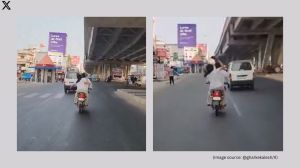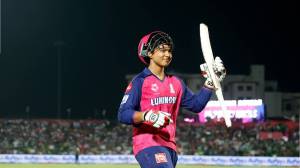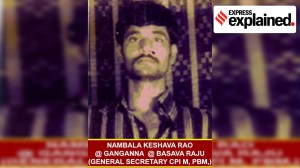UPSC Key: FATF GREY list, SECC 2011 and Green Hydrogen Certification
Why religion and military is relevant to the UPSC exam? What is the significance of topics such as US-Ukraine mineral deal, Carbon Credit Trading Scheme and Yamuna River pollution on both the preliminary and main exams? You can learn more by reading the Indian Express UPSC Key for May 2, 2025.
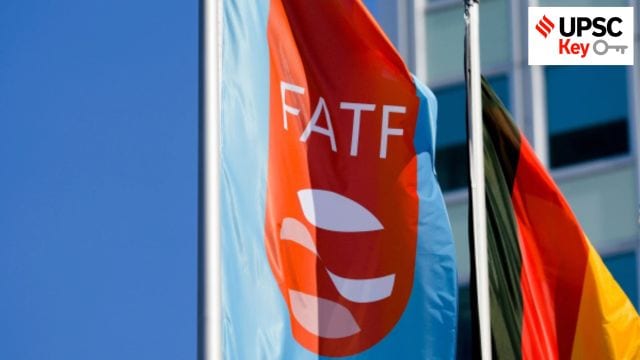 UPSC Key May 2025: Here's what you should be reading from the May 2, 2025 edition of The Indian Express
UPSC Key May 2025: Here's what you should be reading from the May 2, 2025 edition of The Indian Express Important topics and their relevance in UPSC CSE exam for May 2, 2025. If you missed the May 1, 2025 UPSC CSE exam key from the Indian Express, read it here
THE WORLD
Ukraine, US ink minerals deal sought by Trump, set up fund for reconstruction
Syllabus:
Preliminary Examination: Current events of national and international importance.
Main Examination: General Studies II: Bilateral, regional and global groupings and agreements involving India and/or affecting India’s interests.
What’s the ongoing story: Washington and Kyiv have finalised a landmark natural resources agreement, positioning US investment in Ukraine’s rare earth deposits as a strategic economic commitment — despite the absence of any security guarantees for Ukraine.
Key Points to Ponder:
• What are rare earth deposits?
• What is the difference between critical minerals and rare earth elements?
• Which country has the most rare earth deposits?
• The latest minerals deal of US and Ukraine—what you know so far?
• The US-Ukraine mineral deal—what are the terms and conditions?
• Why was the deal signed?
• What is joint Reconstruction Investment Fund?
• How does the deal work?
• What resources is Ukraine offering?
• What does this mean for Ukraine’s security?
Key Takeaways:
• The deal comes after delays caused by tensions between US President Donald Trump and Ukrainian President Volodymyr Zelenskyy, and signals a pivot from military aid to economic investment as the cornerstone of US-Ukraine relations.
• Trump has long demanded that Ukraine compensate the US for past aid, reportedly seeking as much as $500 billion — far exceeding the $120 billion it provided, according to the Germany-based Kiel Institute.
• Zelenskyy rejected that proposal, declaring he would not sign a deal that “ten generations” of Ukrainians would be burdened with repaying.
• Ukraine ultimately agreed to the new minerals-focused deal to secure long-term US involvement without accepting unsustainable debt. As Trump reduces America’s global security commitments, including efforts to block Ukraine’s NATO bid, Kyiv views this economic partnership as a lifeline.
• According to Ukrainian officials quoted by AP, the final version signed Wednesday was significantly more favourable than the original draft. Early versions, nearly signed in a tense Oval Office meeting with Trump, Vice-President JD Vance, and Zelenskyy, would have made Ukraine a junior partner and granted Washington broad extraction rights.
• Economy Minister Yulia Svyrydenko said the revised deal reflects “mutually beneficial conditions” and respects Ukraine’s sovereignty. She noted that it recognises Ukraine’s past contributions to global security, including its decision to give up its nuclear arsenal.
• The agreement must still be ratified by the Ukrainian parliament, and Kyiv views it as a strategic move to tie continued American interest to Ukraine’s survival and prosperity.
Do You Know:
• Key Terms of Ukraine-US Resource Agreement
—Full Sovereignty: Ukraine retains complete control over all subsoil assets, infrastructure, and natural resources.
—No Repayment to US: Ukraine is not required to repay any past US military or financial support as part of this agreement.
—10-Year Reinvestment Clause: All profits generated will be reinvested within Ukraine for the first ten years of the agreement.
—Infrastructure Priority: Initial funding will focus on developing mineral extraction, oil, gas, and related infrastructure before profit-sharing begins. The fund’s profits will be reinvested exclusively in Ukraine for the first 10 years, particularly in mining, oil and gas, infrastructure, and processing projects. Ukraine will not be required to repay any debt for prior US support.
The US International Development Finance Corporation will anchor the fund, with Washington contributing direct capital and military equipment — including air defence systems — while Ukraine will funnel 50 per cent of all future profits from government-owned resources into the fund.
• Ukraine holds an estimated 5% of the world’s rare earth elements, which are crucial for technology like smartphones, electric vehicles, and defence systems. The country also boasts 20% of global graphite reserves, large titanium and manganese supplies, and significant lithium deposits — including one at Novopoltavske, described as among the world’s largest.
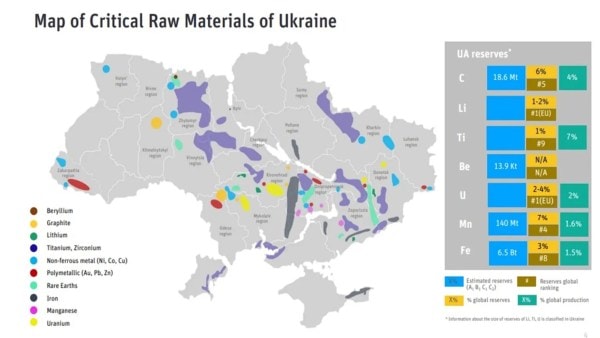 Source: Ukrainian Geological Survey and Ministry of Environmental Protection and Natural Resources of Ukraine
Source: Ukrainian Geological Survey and Ministry of Environmental Protection and Natural Resources of Ukraine
However, much of Ukraine’s mineral wealth remains untapped, with some sites located in Russian-occupied territory. The lack of accurate geological data and decades of underdevelopment further hinder progress.
Other Important Articles Covering the same topic:
Previous year UPSC Prelims Question Covering similar theme:
1. Recently, there has been a concern over the short supply of a group of elements called ‘rare earth metals’. Why? (2012)
1. China, which is the largest producer of these elements, has imposed some restrictions on their export.
2. Other than China, Australia, Canada and Chile, these elements are not found in any country.
3. Rare earth metals are essential for the manufacture of various kinds of electronic items and there is a growing demand for these elements.
Which of the statements given above is/are correct?
(a) 1 only
(b) 2 and 3 only
(c) 1 and 3 only
(d) 1, 2 and 3
FRONT PAGE
India works to throttle Pak terror funding, get it back in watchdog FATF ‘grey list’
Syllabus:
Preliminary Examination: Current events of national and international importance.
Main Examination: General Studies II: Important International institutions, agencies and fora- their structure, mandate.
What’s the ongoing story: AS PART of its escalatory matrix against Pakistan for the terror attack in Pahalgam on April 22, India is considering two specific moves aimed at curbing financial flows that aid the neighbour fund terror activities.
Key Points to Ponder:
• What is the Financial Action Task Force (FATF)?
• How many lists are there under Financial Action Task Force (FATF)?
• What is FATF GREY list?
• Why Pakistan was on it?
• How grey-list under FATF impacts country?
• Removal of Pakistan from FATF Grey List-how it affected India?
• How India Can Put Pakistan on the FATF Grey List?
Key Takeaways:
• The first is to make a concerted effort to try and bring back Pakistan into the ‘grey list’ of Financial Action Task Force (FATF), the global money laundering and terror financing watchdog, two people in the know told The Indian Express.
• Pakistan was put in the ‘grey list’ in June 2018, and faced “increased monitoring” till it was removed in October 2022. Being in this list adversely impacts FDI and capital flows as businesses have to undertake enhanced due diligence. Government officials said this had helped curtail illicit fund flows from Pakistan into India, especially into J&K.
• The second is to raise objections to the International Monetary Fund’s (IMF’s) continued financing of a $7-billion aid package that commenced July 2024, citing diversion of funds by Pakistan for nefarious activities and terror attacks, people in the know said.
• To initiate a nomination process demanding a ‘grey list’ status for Pakistan, India would require the support of other FATF member countries. “There has been a discussion on the steps that could be taken on the financial front. Demanding a ‘grey list’ for Pakistan at the FATF is on the table. But there is a nomination process in FATF and members can ask for taking up the matter, that can be approved by the Plenary,” an official in the know of developments said.
• The plenary is the decision-making body of the FATF, which meets three times a year, usually in February, June and October. The nomination will be based on specific money laundering, terrorist financing (TF), or proliferation financing risks or threats faced by a country.
• The FATF has 40 members, and over 200 jurisdictions have committed to the FATF recommendations through the FATF-Style Regional Bodies. New Delhi has its task cut out since it would have to rally adequate support among member countries for a move of this nature.
• A gauge of this support comes from the condolence messages New Delhi received from as many as 23 FATF member countries, including the UK, the US, France, Germany, Australia, European Commission, and Gulf Cooperation Council heavyweights such as Saudi Arabia and the UAE.
• Pakistan is not a member of FATF, but of Asia Pacific Group on Money Laundering (APG), the largest FATF-Style Regional Body. India is a member of APG as well as of the FATF.
Do You Know:
• The FATF is the global money laundering and terrorist financing watchdog. The Paris-based intergovernmental organisation was formed in 1989 as a G7 initiative to examine and develop measures to combat money laundering. In 2001, the FATF expanded its mandate to also combat terrorist financing.
• The FATF, a 40-member body, has outlined a framework of measures to help countries tackle illicit financial flows. These are listed as 40 Recommendations that are divided into seven distinct areas: (1) AML/CFT Policies and coordination, (2) Money laundering and confiscation, (3) Terrorist financing and financing of proliferation, (4) Preventive measures, (5) Transparency and beneficial ownership of legal persons and arrangements, (6) Powers and responsibilities of competent authorities and other institutional measures, (7) International cooperation.
• India became a member of FATF in 2010. Prior to this report, the FATF had undertaken an evaluation for India in June 2010. India was then placed in the “regular follow-up” category, but was subsequently removed after a follow-up report in June 2013. Due to the pandemic and pause in the FATF’s assessment process, the next round of mutual evaluation had been postponed to 2023. India’s onsite assessment by FATF happened in November last year, while the assessment came up for discussion in the plenary discussion in June 2024.
• The FATF monitors countries to ensure they implement the FATF standards fully and effectively. FATF mutual evaluations are in-depth country reports that analyse the implementation and effectiveness of measures taken against money laundering, terrorist and proliferation financing.
Other Important Articles Covering the same topic:
📍FATF report on India and the significance of the observations
Pasmanda Muslims likely to be counted as OBCs in caste census
Syllabus:
Preliminary Examination: Current events of national and international importance.
Mains Examination: General Studies I: Social empowerment
What’s the ongoing story: IN THE enumeration of castes to be done in the forthcoming Census, as announced by the government Wednesday, Pasmanda Muslims as a whole may figure in the Other Backward Classes (OBCs) category.
Key Points to Ponder:
• Who are the Pasmanda Muslims?
• Are Muslims divided along caste lines?
• What percentage of Indian Muslims are Pasmanda, and where do they live?
• What is the history of the Pasmanda movement?
• Which commission recommended the inclusion of Dalit Muslims and Christians in the Scheduled Caste category?
Key Takeaways:
• “Pasmanda Muslims will be given their due share in the national caste census,” said a senior BJP leader. Leaders of the BJP Minority Morcha and OBC Morcha confirmed the same.
• “As per the Mandal Commission recommendations, some groups among Muslims are included in the state and Central list of Backward Classes. These Muslims will be enumerated as such in the caste census (among OBCs),” K Laxman, the national president of the BJP’s OBC Morcha, told The Indian Express.
• The national president of the BJP Minority Morcha, Jamal Siddiqui, said: “Pasmanda Muslims too are citizens of this country. So they will be enumerated as per their backwardness in the caste census.”
• Supporting such a distinction for Pasmanda Muslims, a Pasmanda Muslim activist said the Ashraf Muslims (who are seen as the ‘elite’), and Pasmanda Muslims, including the Ajiafs (Backward Muslims) and Arzals (Dalit Muslims), cannot be considered as a single bloc.
Do You Know:
• ‘Pasmanda’, a Persian word, means the ‘ones left behind’, and is used to describe depressed classes among the Muslims. The Sachar Committee in its report put the number of OBC and SC/ST Muslims at 40% (all India 2004-05). But Pasmanda activists and scholars say that the Pasmandas make up 80-85% of the total Muslim population in India.
• This broadly tallies with the 1871 Census that said only 19% of Muslims in India were upper caste, while 81% were made up of the lower castes.
• While confirming that Pasmandas may be counted as OBCs in the caste census, Laxman made a distinction between the surveys conducted by Bihar and Telangana, both of which counted Pasmanda Muslims among backward classes.
• Muslim society in India consists of several status groups or biradaris that are broadly sorted in three categories: the Ashrafs (the ‘noble’ elite or the ‘honourable ones’), the Ajlafs (backward Muslims), and the Arzals (Dalit Muslims).
Ashrafs in India are Muslims who either claim to have a foreign pedigree — descendants of Muslims from Arabia, Persia, Turkey, Afghanistan (Syeds, Sheikhs, Mughals and Pathans,) — or who are upper-caste converts from Hinduism (Rajput, Gaur, Tyagi Muslims among others).
• Ajlafs are middle-caste converts, who were into ritually “clean” occupations, while the Arzals — who were first recorded in the 1901 census — are from the lowest, “untouchable” castes like halalkhors, helas, lalbegis or bhangis (scavengers), dhobis (washermen), nais or hajjams (barbers), chiks (butchers), and faqirs (beggars).
• The momins or julahas (weavers), darzi or idiris (tailors), rayeens or kunjaras (vegetable sellers) fall in the Ajlaf bracket.
While Islam does not mandate the creation of such groups, these caste categories are a lived reality for Muslims across the country.
“One can discern three groups among Muslims: (1) those without any social disabilities, the Ashrafs; (2) those equivalent to Hindu OBCs, the Ajlafs, and (3) those equivalent to Hindu SCs, the Arzals. Those who are referred to as Muslim OBCs combine (2) (Ajlafs) and (3) (Arzals),” the Rajinder Sachar Committee, formed in 2005 to study social, economic and educational condition of Indian Muslims, said in its report.
However, The Constitution (Scheduled Caste) Order, 1950, had restricted SC status to Hindus, keeping Dalits from other religions out of its ambit. The order was later amended (in 1956 and 1990) to include Sikhs and Buddhists.
• The implementation of the report of the Mandal Commission brought the non-Ashrafs — Ajlafs and Arzals — under the OBC category.
• The National Commission for Religious and Linguistic Minorities, known as the Justice Ranganath Mishra Commission, which submitted its report in May 2007, acknowledged that the caste system impacted all religious communities in India, including Muslims.
• In the absence of a caste census, a clear estimate of the present-day numbers and demographic distribution of Pasmanda Muslims is not available. The Sachar Committee in its report put the number of OBC and SC/ST Muslims at 40% (all India 2004-05).
Other Important Articles Covering the same topic:
📍Explained: Who are Pasmanda Muslims, focus of BJP outreach?
Yamuna clean-up: Clearing drains to razing encroachments in Govt’s plan
Syllabus:
Preliminary Examination: General issues on Environmental ecology, Bio-diversity and Climate Change
Mains Examination: General Studies III: Conservation, environmental pollution and degradation, environmental impact assessment.
What’s the ongoing story: From enhancing environmental flow of the river to managing drains and removing encroachments from floodplains through a dedicated Special Task Force, the Government has finalised a 30-point action plan to rejuvenate the Yamuna, The Indian Express has learnt.
Key Points to Ponder:
• Map Work-Yamuna (Source, Major cities, destination and Tributaries)
• What National Green Tribunal said for Yamuna restoration in past?
• What status report on the rejuvenation of the river submitted by the Delhi government says?
• Discuss the major causes of Yamuna River pollution
• What is the key component of the Delhi government’s plan to clean the Yamuna River?
• Effectiveness of decentralised sewage treatment plants (STPs) in urban wastewater management—Comment
• What can be the socio-economic implications of razing encroachments along the Yamuna floodplains in the context of environmental conservation and urban development?
Key Takeaways:
• The plan, which involves the Central and Delhi governments, was drawn up following a high-level meeting chaired by Prime Minister Narendra Modi on April 16 to review the clean-up and address the capital’s drinking water concerns.
• Sources said that a detailed presentation on the initiative was shared during the meeting, which was also attended by Union Home Minister Amit Shah, Union Jal Shakti Minister C R Patil, Delhi Chief Minister Rekha Gupta and senior PMO officials.
• Following the meeting, sources said, the 30-point roadmap was circulated among key agencies — Delhi Development Authority (DDA), National Mission for Clean Ganga (NMCG), Central Pollution Control Board (CPCB), Delhi Jal Board (DJB), Municipal Corporation of Delhi (MCD) — and the Delhi government. Each of them has been assigned specific responsibilities, with timelines ranging from June 2025 to March 2029.
• Two key action points in the exercise focus on increasing the environmental flow (E-flow) of the Yamuna within Delhi and further downstream. E-flow refers to the quantity, timing and quality of water flow needed to maintain the health and function of aquatic ecosystems.
• The plan proposes discharging 773 million litres per day (8.95 cumecs) of treated water from the Coronation Pillar and Yamuna Vihar sewage treatment plants into the river downstream of Wazirabad by September 2026 — a dedicated conveyance system will be developed.
• Additionally, an extra 6.23 cumecs of treated water from the Okhla STP (capacity: 563 MLD) will be released downstream of the Okhla barrage via the Yamuna canal, partially improving the river’s flow.
Do You Know:
• Main points of the 30-point action plan for cleaning the Yamuna
1. E-flow in the Yamuna
2. Drain management
3. Solid waste management
4. Sewage management
5. Governance and enforcement
6. Gap identification/monitoring and surveillance system
7. Flood plain protection/river-front development activities
8. Public outreach
9. Septage and dairy waste management
Other Important Articles Covering the same topic:
📍Why Yamuna in Delhi has high ammonia levels
Previous year UPSC mains Question Covering similar theme:
📍Industrial pollution of river water is a significant environmental issue in India. Discuss the various mitigation measures to deal with this problem and also the government’s initiatives in this regard. (2024)
📍Discuss the Namami Gange and National Mission for Clean Ganga (NMCG) programmes and causes of mixed results from the previous schemes. What quantum leaps can help preserve the river Ganga better than incremental inputs? (2015)
GOVT & POLITICS
Iran minister likely to visit India, discuss terror attack
Syllabus:
Preliminary Examination: Current events of national and international importance.
Main Examination: General Studies II: Bilateral, regional and global groupings and agreements involving India and/or affecting India’s interests.
What’s the ongoing story: Days after he conveyed his intention to mediate between India and Pakistan over the Pahalgam terror attack, Iran’s Foreign Minister Abbas Araghchi is expected to arrive in New Delhi next week, it is learnt.
Key Points to Ponder:
• What is the role of Iran as a mediator in the India-Pakistan conflict following the Pahalgam terror attack?
• Know the impact of the Pahalgam terror attack on India-Pakistan relations and the subsequent geopolitical developments in South Asia.
• Do you think that international mediations are as effective as bilateral talks?
• Know the role of global powers, such as the United States and China, in de-escalating tensions between India and Pakistan after major terror incidents.
Key Takeaways:
• Sources said the likely date of Araghchi’s arrival is May 8, but an official announcement is yet to be made in the backdrop of fast-paced developments taking place between India and Pakistan over the terror attack in which 26 people were killed.
• Sources in the Iranian Embassy in New Delhi said Araghchi is expected to hold detailed discussions with External Affairs Minister S Jaishankar “on all aspects of the Pahalgam attack, besides other issues of bilateral, regional and global importance”.
• On April 25, three days after the terror attack, Araghchi posted on X, “India and Pakistan are brotherly neighbours of Iran, enjoying relations rooted in centuries-old cultural and civilisational ties. Like other neighbors, we consider them our foremost priority.” He said Tehran was ready to “use its good offices in Islamabad and New Delhi to forge greater understanding at this difficult time”. The Iranian minister also dialed Pakistan Deputy PM and Foreign Minister Muhammad Ishaq Dar and discussed the situation.
• Araghchi’s visit, if it happens, will take place at a crucial juncture of Iran-US talks. The fourth round of talks between Iran and the US is scheduled in Rome on Saturday, a day after Tehran holds discussions with E3 countries — France, Britain and Germany — on Friday.
• Four days after the Pahalgam attack, Iranian President Masoud Pezeshkian spoke to Prime Minister Narendra Modi and strongly condemned the terror attack, as per the Ministry of External Affairs.
Do You Know:
• Trade is an important aspect of India-Iran relations, with New Delhi ranking among Tehran’s top five trading partners in recent years. In October last year, PM Modi and President Pezeshkian held a meeting on the sidelines of the BRICS Summit in Russia’s Kazan, with both leaders discussing the importance of peace in West Asia. Pezeshkian highlighted India’s potential role in de-escalating conflict in the region due to its good relations with all involved parties.
Other Important Articles Covering the same topic:
📍‘Our foremost priority’: Iran offers to mediate between India, Pakistan
EXPLAINED
Syllabus:
Preliminary Examination: Current events of national and international importance.
Main Examination: General Studies II: India and its neighbourhood- relations.
What’s the ongoing story: Fighting India, overtly and covertly, has historically been the raison d’être of the Pakistan Army. So when Pakistani terrorists shot dead 26 civilians near Pahalgam on April 22, all eyes turned to the Pakistan Army and its proxies.
Key Points to Ponder:
• Who is Asim Munir?
• Why Asim Munir is called as jihadi general or Pakistan’s first “mullah general”?
• How is religion related to national security in Pakistan’s case?
• How does religion affect national security or military?
• Can religion and military go hand in hand?
• What is the impact of General Asim Munir’s leadership on Pakistan’s civil-military relations and its implications for democratic governance?
• What is the role of General Asim Munir in shaping Pakistan’s foreign policy?
• What can be the implications of General Asim Munir’s religious orientation on the Pakistan Army’s operational strategies and internal policies?
Key Takeaways:
• Only a week ago, Chief of the Army Staff General Asim Munir, the most powerful man in Pakistan, had made a provocative speech which New Delhi views as having encouraged the terrorists.
• Calling Kashmir Pakistan’s “jugular vein” — a framing first used by Muhammad Ali Jinnah — the Pak Army chief said in Islamabad on April 15 that Pakistan “will not leave its Kashmiri brothers.”
• In February, at an event in Muzaffarabad in Pakistan Occupied Kashmir (PoK), Munir had gone a step further. “Cutting the jugular vein off the body means the end of life,” he had said, adding that “Allah’s… (Muslim fighters) will always prevail based on faith, piety, and jihad in the way of Allah.”
• As Pakistani generals go, Munir, 57, is an outlier in more ways than one.
• Ramanathan Kumar, who headed the Pakistan desk at R&AW from 2015 to 2020, had earlier described Munir to The Indian Express as Pakistan’s first “mullah general”. While posted as a military attaché in Saudi Arabia, Munir, then a 38-year-old Lieutenant Colonel, had memorised the Holy Quran, a feat that earned him the title of Hafiz-e-Koran.
• As the Pak Army chief, Munir freely uses Quranic verses and Islamic theology in his speeches, switching seamlessly from English or Urdu to classical Arabic.
• Clues to Munir’s religiosity lie in his origins. Unlike many of his peers in the top echelons of the Pak Army, he does not belong to a pedigreed military family. Instead, his father, who arrived in Rawalpindi from Jalandhar in 1947, was a school principal and the imam of the local mosque.
Do You Know:
• Unlike many Pakistani generals, Munir has never served in the West or received training in British or American military institutes. He is, however, understood to be a soldier to the core — a reputation that is responsible for his somewhat improbable rise in the Army, as well as him being nearly cast into oblivion in 2019.
• Munir was serving as a Brigadier in the Force Command Northern Areas at the Indian frontier, when he caught the attention of then X Corps Commander Lt General Qamar Javed Bajwa. Their relationship would be instrumental in Munir’s eventually succeeding Bajwa as the Army chief.
• In early 2017, Munir was posted as Director General of Military Intelligence (DGMI), the Pak Army’s administrative intelligence apparatus that maintains organisational security, and also gathers intelligence on the capabilities of adversaries’ ground forces.
• In March 2018, then Major General Munir was awarded the Hilal-e-Imtiaz, Pakistan’s second-highest state honour. In September, he was promoted to the rank of Lieutenant General, before being made the chief of the Inter-Services Intelligence (ISI) in October.
• The insurgency in Balochistan is intensifying, as are the troubles with the Pakistan Taliban and the regime in Kabul. On March 11, Baloch separatists hijacked the Jaffar Express, taking hundreds hostage. The incident eventually led to 64 deaths. Targeted killings of Punjabis, Shias, Sindhis and Chinese nationals have been frequent in Balochistan and Khyber-Pakhtunkhwa.
Other Important Articles Covering the same topic:
📍Why Pahalgam? Asim Munir’s desperation is telling
SECC 2011, the last time caste data was collected (but not published)
Syllabus:
Preliminary Examination: Economic and Social Development-Sustainable Development, Poverty, Inclusion, Demographics, Social Sector Initiatives, etc.
Main Examination: General Studies II: Welfare schemes for vulnerable sections of the population by the Centre and States and the performance of these schemes; mechanisms, laws, institutions and Bodies constituted for the protection and betterment of these vulnerable sections.
What’s the ongoing story: The most recent data on the populations of individual castes and tribes in India were collected between 2011 and 2013 as part of the Socio Economic and Caste Census (SECC), 2011, an exercise that followed the Census of 2011.
Key Points to Ponder:
• Discuss the significance of the Socio-Economic and Caste Census (SECC) 2011 in promoting inclusive policy-making in India.
• Know the constitutional, administrative, and political challenges associated with the release of caste data collected in SECC 2011.
• What is the difference between caste census and socio economic caste census?
• What do you understand by caste census?
• Why caste census this time?
• How caste census will ensure social justice?
• Why has the caste data not been released yet?
• Know the historical context and significance of conducting a caste census in India after nearly a century.
• Critically analyze the implications of a caste census for federalism in India.
Key Takeaways:
• The SECC collected data on a range of parameters, parts of which were published in 2016. But the data on caste populations, other than the total numbers of SCs and STs, was not made public.
• The wartime Census of 1941 collected data on individual castes, which were, however, not released. Censuses in independent India have never collected disaggregated caste data.
• As such, the most recent publicly available data on caste populations at the national level are from the 1931 Census, which will serve as the baseline for the caste data that the government has now decided to collect as part of the upcoming, pandemic-delayed Census 2021.
Do You Know:
• SECC 2011 was a study of socio-economic status of rural and urban households, and allowed the ranking of households based on predefined parameters.
The Union Ministry of Rural Development began the SECC on June 29, 2011 through a nationwide door-to-door enumeration exercise. It was mainly carried out in 2011 and 2012, but in a few states, enumeration and verification went on until 2013.
The data, which were to be used for policy, research, and the implementation of various development programs, were compiled from 24 lakh enumeration blocks, each containing around 125 households.
• The caste census was under the administrative control of the Ministry of Home Affairs, through the Registrar General of India (RGI) and Census Commissioner of India.
Census 2011 was carried out before the SECC, between February 9 and February 28, 2011. Personal data collected in the population Census are confidential.
But all personal information in SECC is open for use by government departments to grant and/ or restrict benefits to households.
Other Important Articles Covering the same topic:
📍Caste census to be held with national Census, Shah calls it historic
Previous year UPSC Prelims Question Covering similar theme:
2. Consider the following statements: (2009)
2. Between Census 1951 and Census 2001, the density of the population of India has increased more than three times.
3. Between Census 1951 and Census 2001, the annual growth rate (exponential) of the population of India has doubled.
Which of the statements given above is/are correct?
(a) 1 only
(b) 2 only
(c) Both 1 and 2
(d) Neither 1 nor 2
ECONOMY
Certification scheme, carbon offset rules likely to boost green hydrogen ecosystem
Syllabus:
Preliminary Examination: Economic and Social Development–Sustainable Development, Poverty, Inclusion, Demographics, Social Sector Initiatives, etc.
Mains Examination: General Studies II: Government policies and interventions for development in various sectors and issues arising out of their design and implementation
What’s the ongoing story: To boost India’s green hydrogen exports and encourage energy-intensive sectors to adopt the emerging fuel, the Centre has introduced a certification scheme under the National Green Hydrogen Mission and notified rules for claiming emission offsets under the Carbon Credit Trading Scheme (CCTS).
Key Points to Ponder:
• What is green hydrogen certification?
• What is Green hydrogen standard?
• What is green hydrogen?
• Hydrogen and its Types
• How green hydrogen differs from traditional emissions-intensive ‘grey’ hydrogen and blue hydrogen?
• How is the policy set to boost domestic production of green hydrogen production?
• What are the facilities to boost export of green hydrogen?
• What are the challenges and opportunities associated with the Green Hydrogen Certification Scheme in India.
• What are carbon credits and how does India’s Carbon Credit Trading Scheme (CCTS) aim to operationalize them?
• Compare and contrast the green hydrogen policies of India with those of developed nations such as Germany or Japan.
Key Takeaways:
• Union Minister of New and Renewable Energy Pralhad Joshi on April 29 launched a scheme to measure, monitor, report, verify on-site, and certify green hydrogen based on a standard introduced by the Ministry in 2023.
• “This will help to ensure that the hydrogen produced in India truly qualifies as green. A lot of greenwashing tends to happen these days, which is why certification is most important. With the certification in place, our green hydrogen will carry a mark of quality and credibility, making it globally desirable and export-ready,” Joshi said about the scheme.
• On April 27, the Bureau of Energy Efficiency (BEE), nodal agency for the Green Hydrogen Certification Scheme, also announced an offset mechanism for hard-to-abate sectors using green hydrogen under CCTS, to allow them to earn and trade credits.
• While CCTS does not yet include sectors like steel, refineries, and shipping, where there is a use case for switching to green hydrogen, the latest guidelines will provide industry greater clarity on compliance before the ambit of CCTS eventually widens.
Do You Know:
• Green hydrogen is produced by splitting water through electrolysis, using an electrolyser that is powered by renewable energy. Green hydrogen has specific advantages. One, it is a clean burning molecule, which can decarbonise sectors including iron and steel, chemicals, and transportation. Two, renewable energy that cannot be stored or used by the grid can be channelled to produce it.
• In 2023, the Ministry of New and Renewable Energy (MNRE) introduced a green hydrogen standard, capping emissions at 2 kg of CO2 per kg of hydrogen produced. The certification scheme, based on the standard, applies only to green hydrogen production from electrolysis or conversion of biomass.
• With the scheme in place, the export appeal of Indian green hydrogen is likely to increase. At the launch, Joshi said India has signed an agreement with Japan to supply over 4 lakh tonnes of green hydrogen derivatives like green ammonia. The heads of terms (HoT) for the cross-border supply of green ammonia to Japan were signed in August last year.
• Still, high production costs remain a hurdle. In March, the Parliament’s Standing Committee on Energy noted that “the current cost of production of green hydrogen is quite high,” and called for green hydrogen hubs to be located in regions rich in renewable energy, water, and proximity to demand centres to be economically viable.
• For exports, the government has identified Kandla, Paradip, and Tuticorin—all with international ports—as key hubs for green hydrogen production.
• At the launch of the green hydrogen certification scheme, Saurabh Diddi, director of BEE, emphasised the importance of ensuring transparency, authenticity, and accountability in green hydrogen production. Diddi also said the certification scheme “will enhance investor confidence and enable producers to access carbon credits”.
• Compared to the rules for green hydrogen certification, the carbon offset mechanism under CCTS sets significantly stricter standards—especially on water use for electrolysis. CCTS guidelines, for instance, cap a project’s water consumption at no more than 5 per cent of the locally available drinking water, to ensure it does not displace other uses.
Other Important Articles Covering the same topic:
Previous year UPSC Prelims Question Covering similar theme:
3. Hydrogen fuel cell vehicles produce one of the following as “exhaust” (2010)
(a) NH3
(b) CH4
(c) H2O
(d) H2O2
| PRELIMS ANSWER KEY |
| 1.(c) 2.(d) 3.(c) |
For any queries and feedback, contact priya.shukla@indianexpress.com
Subscribe to our UPSC newsletter. Stay updated with the latest UPSC articles by joining our Telegram channel – IndianExpress UPSC Hub, and follow us on Instagram and X.
Must Read
Buzzing Now



May 22: Latest News
- 01
- 02
- 03
- 04
- 05









